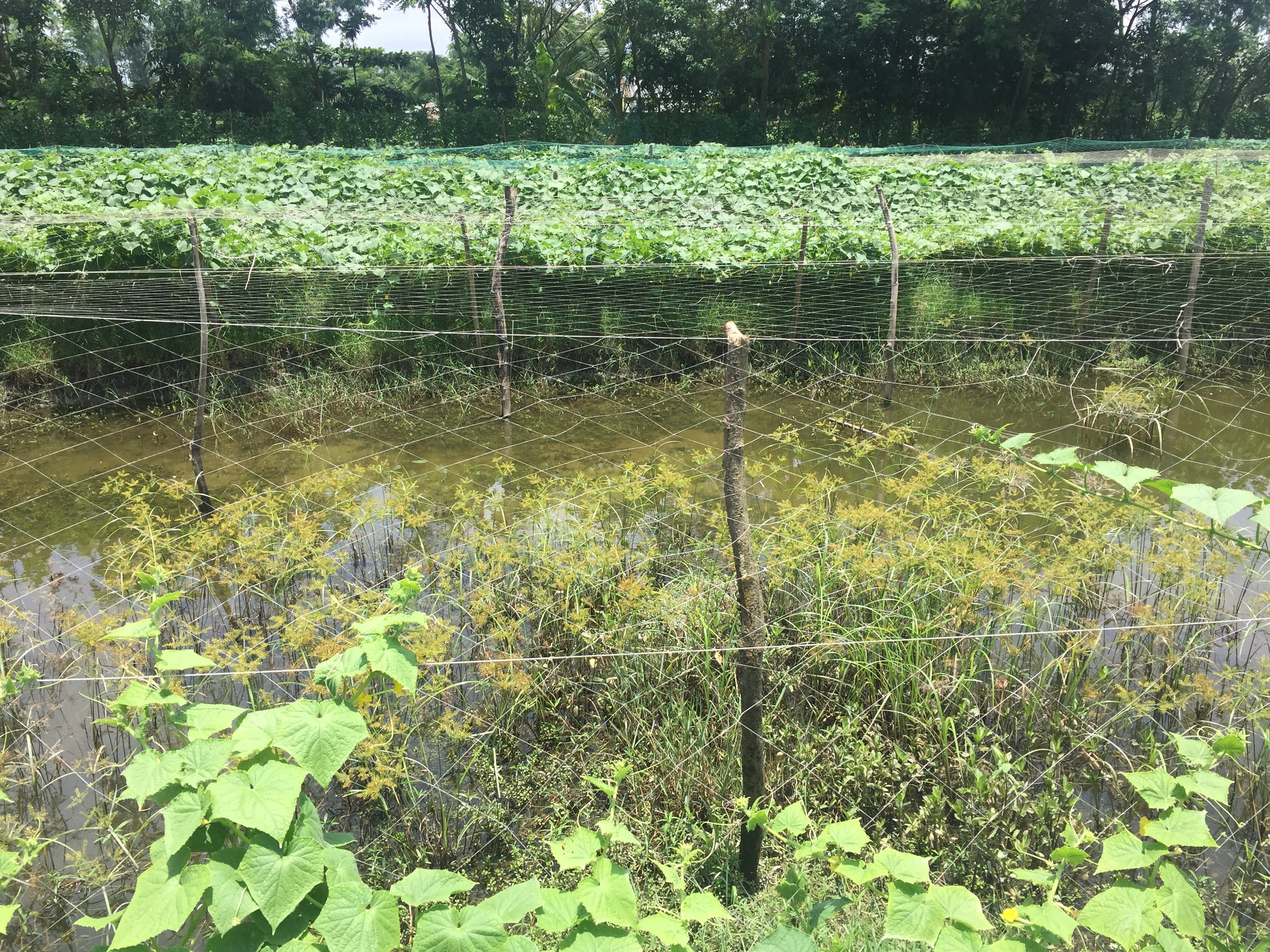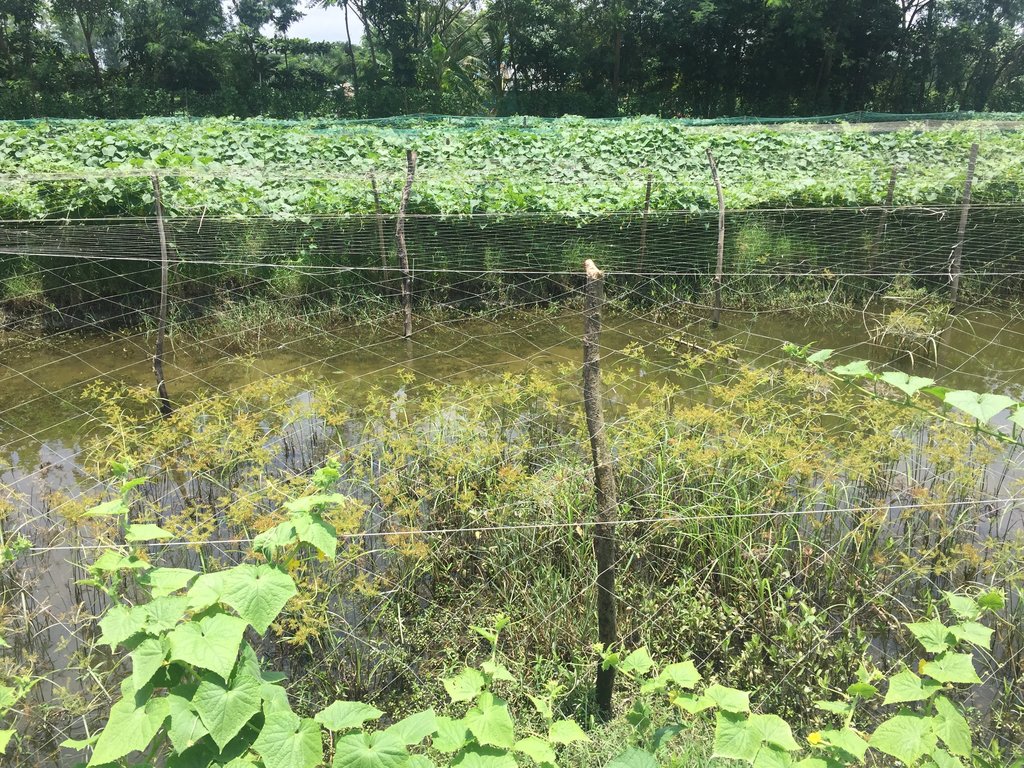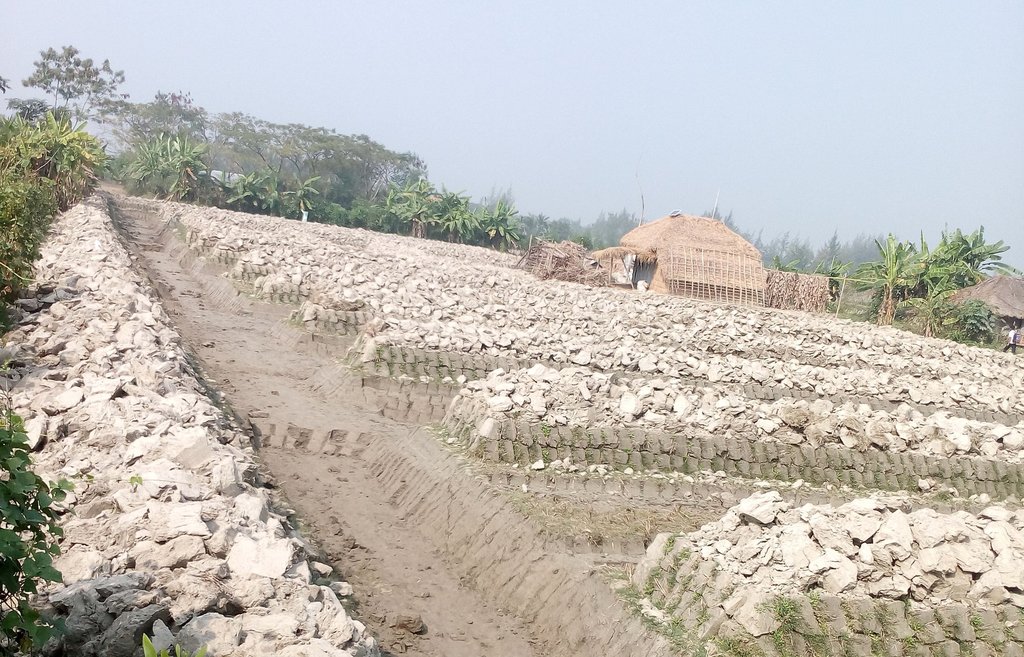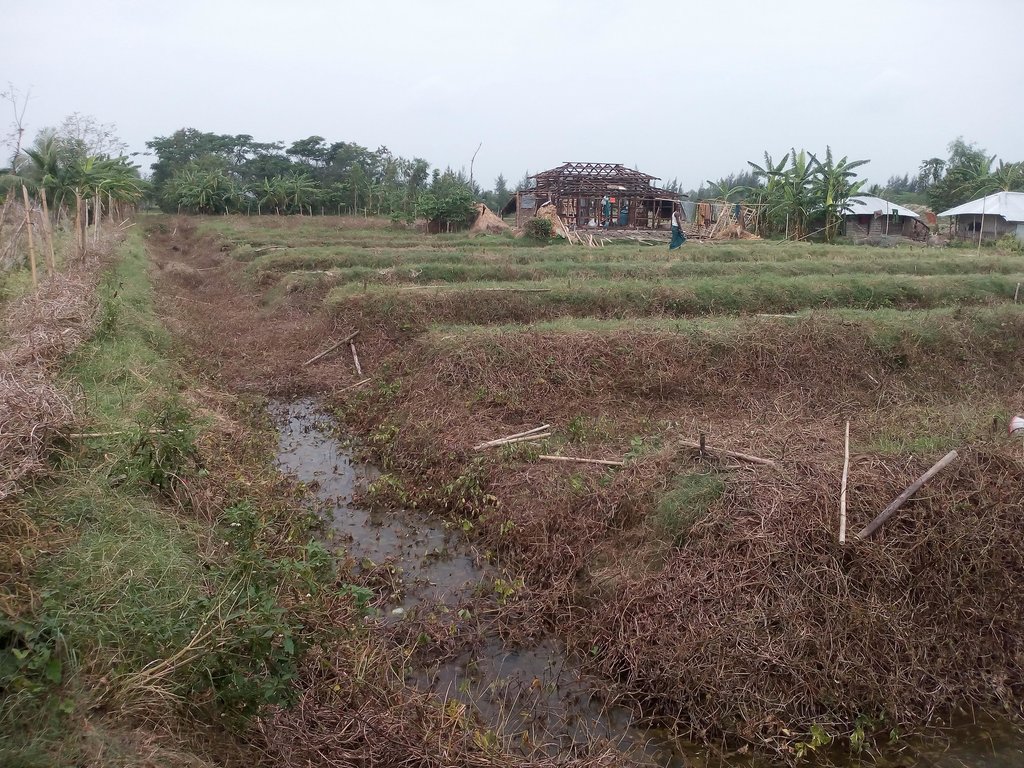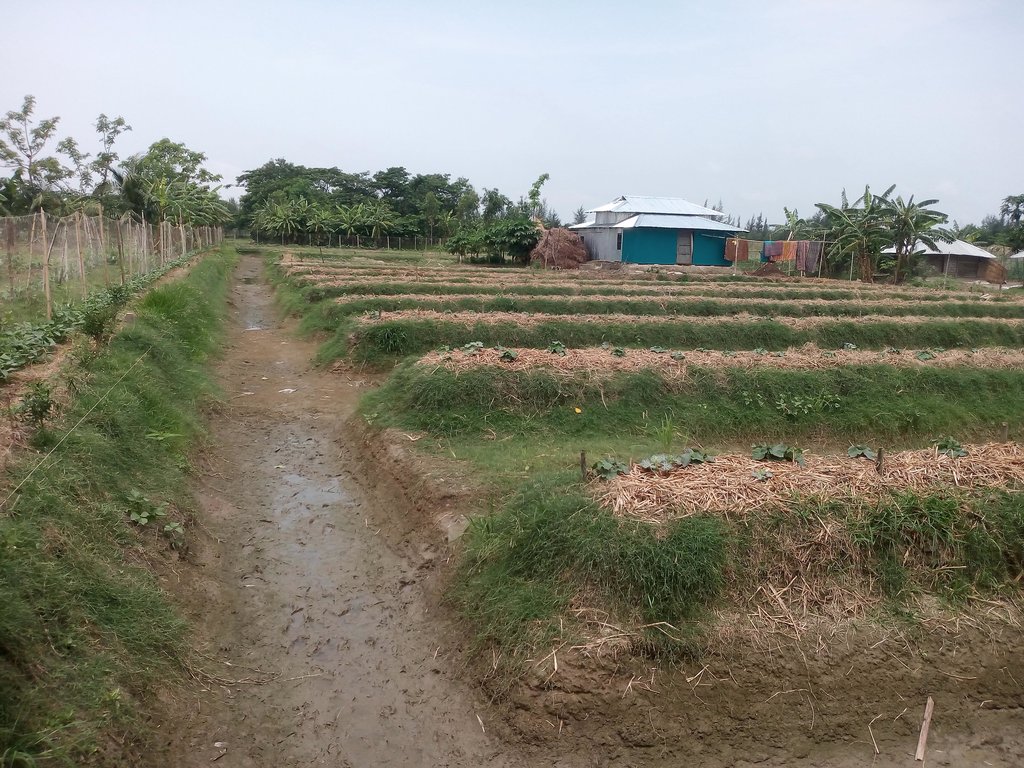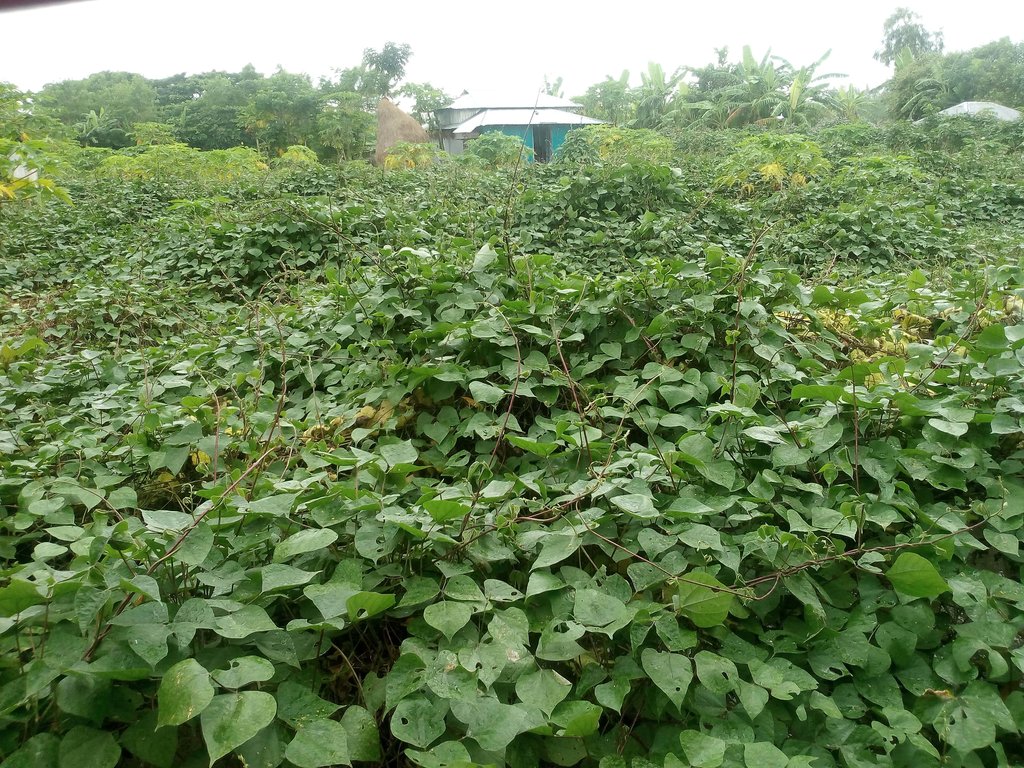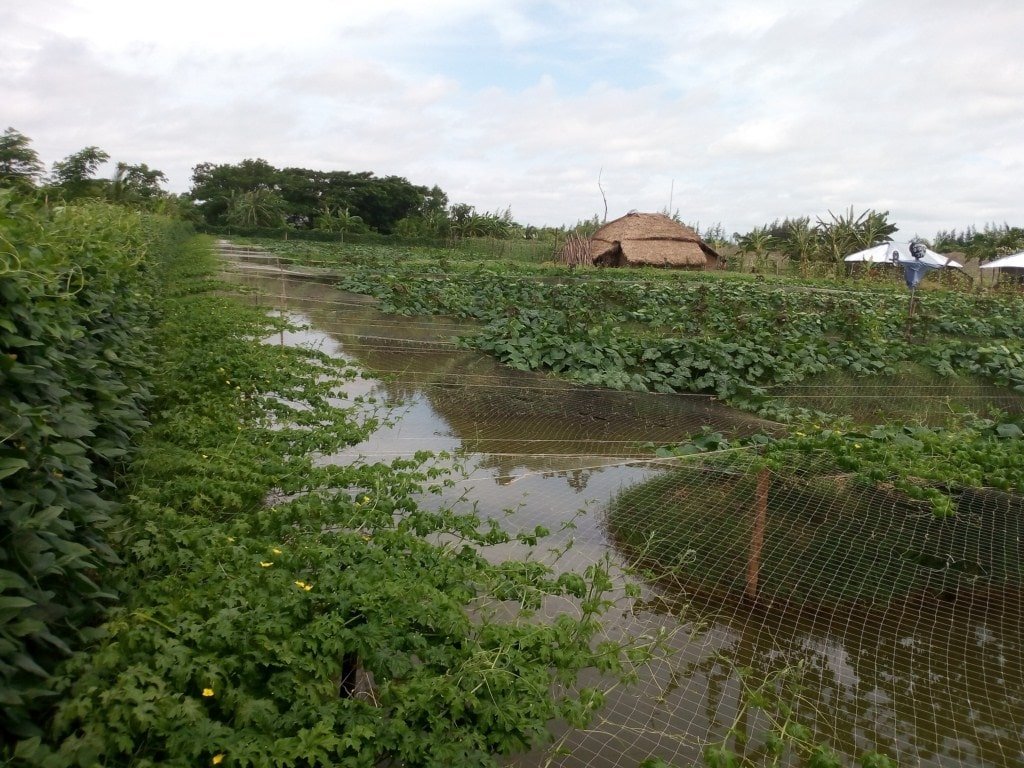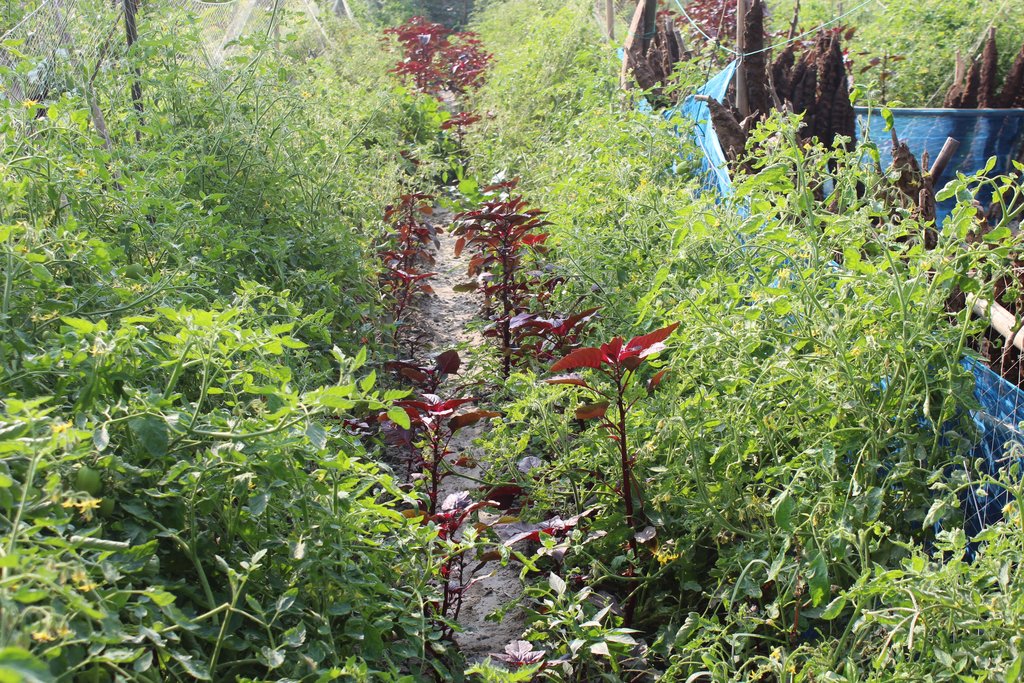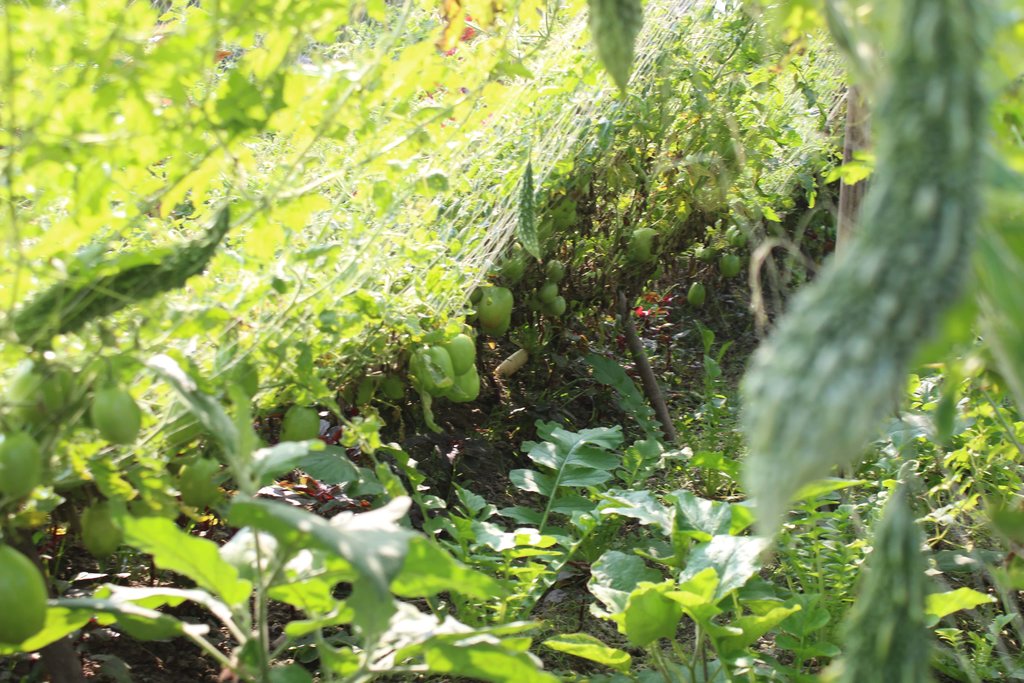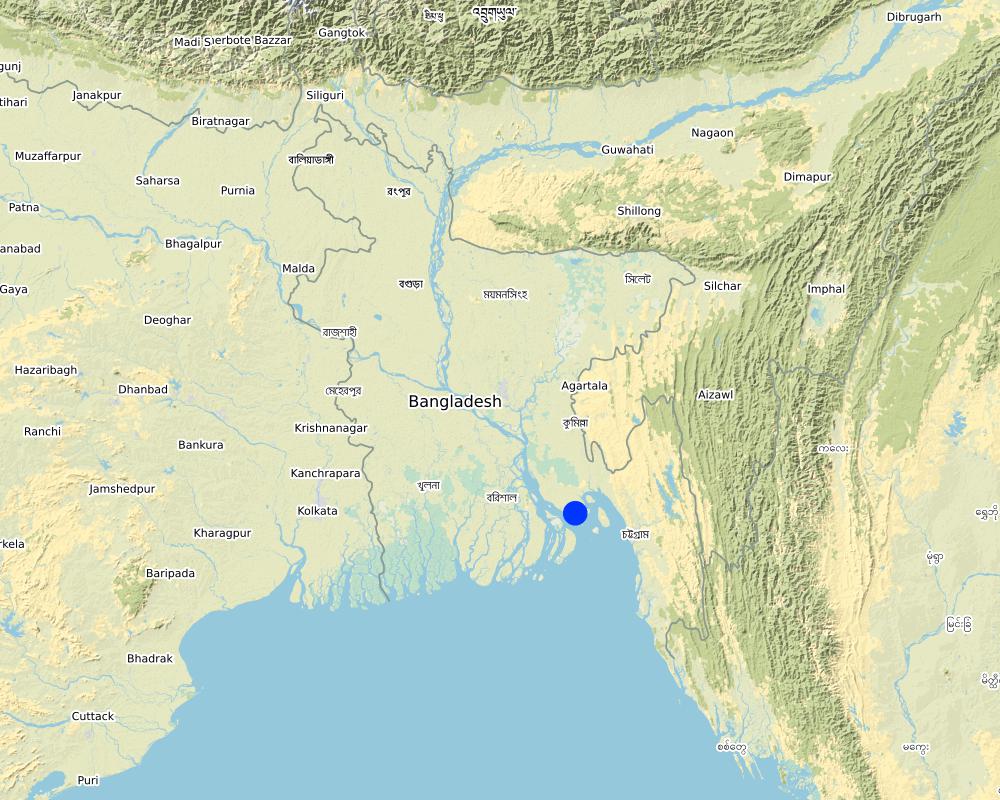Sorjan - growing vegetables on raised beds in waterlogged areas [孟加拉国]
- 创建:
- 更新:
- 编制者: Wolfgang Duifhuizen
- 编辑者: Kiran Sankar Sarker
- 审查者: Rima Mekdaschi Studer, Ursula Gaemperli
technologies_5613 - 孟加拉国
查看章节
全部展开 全部收起1. 一般信息
1.2 参与该技术评估和文件编制的资源人员和机构的联系方式
M&E adviser:
1.3 关于使用通过WOCAT记录的数据的条件
编制者和关键资源人员接受有关使用通过WOCAT记录数据的条件。:
是
1.4 所述技术的可持续性声明
这里所描述的技术在土地退化方面是否存在问题,导致无法被认为是一种可持续的土地管理技术?:
否
2. SLM技术的说明
2.1 技术简介
技术定义:
The sorjon system is the cultivation of vegetables on raised beds. Ridges are about 60 to 90 cm high, which means crops are kept above the water, even during the wet season. The ditches between the ridges hold water for six to eight months per year and can be used to keep fish as well as being a source of water to irrigate the crops.
2.2 技术的详细说明
说明:
The Sorjan is a system that serves as an alternate of deep drains (ditches) and raised beds for crop cultivation and fish rearing. In coastal Bangladesh the ridges are mostly around one meter wide at the top and spaced two meters apart – although in places ridges and spacing can be wider than this. The Sorjan system is applied in lowland areas which suffer from water logging and salinization. The widely spread technology is also practiced in Char Nangulia, Noakhali district in the Meghna estuary in Bangladesh. The main economic activities in this area are small-scale agriculture, livestock keeping, fish rearing and informal business. Before introduction of the Sorjan system (by the Bangladesh by Department of Agriculture Extension) only deep-water tolerant traditional low-yielding paddy could be cultivated during the rainy season and in the dry season, the capillary rise of salty ground water led to poor yields for most crops, if they survived at all.
The beds are about 60 to 90 cm high, which means crops are kept above the water, even during the wet season. The ditches between the ridges hold water for six to eight months per year and can be used to rear fish and ducks as well as being a source of water to irrigate the crops. In most cases nets are spanned over the ditches, allow climbing plants to grow over them utilizing the space in an efficient way. The sorjan system is is applied in low land areas and frequently suffer from water logging and sometimes salt water intrusion. This system with raised bed enables the cultivation of vegetables in these locations.
The main function of Sorjan is to grow crops on raised beds so that roots are protected against stagnant water. As the area is partially excavated, the deeper areas can be used for fish rearing whenever inundated and crops such as cucumber and gourds can grow vines on supporting nets spanned over the ditches to maximize productivity of limited space available. In the Philipines Sorjan system, it has also been reported that rice is cultivated in the ditches with shallow water and at the same time, other crops on the beds.
To install Sorjan a farmer needs to make raised beds for planting the crops and rear fish in the deep drains. This is usually done by hand with help of local laborers, in some cases an excavator is rented to do the job. To support the crop to be planted , a framework of bamboo, string and netting is built over the ditches to support a sequence of climbing plants.
Maintenance of the beds is done regularly whenever necessary and the crop netting is replaced every 3 years. In the area farmers predominantly use urea and other chemical fertilizers to lesser extent, few farmers use animal manure and compost. Most Sorjan ridges have a permanent undergrowth of grass to keep the slopes stable. In some cases, during dry season, goats graze the grass in the ditches and slopes.
Before the rains start in March, cucumbers are planted, and these are followed by a variety of gourds (including snake, bottle, bitter and ribbed gourds) in the early monsoon, with yard long bean (asparagus bean) and country bean (lablab bean) in the later monsoon, with country beans continuing to be harvested through the dry season up to the following March. During dry season the beans are sometimes intercropped with chillies, tomatoes and amaranth. These crops overlap with each other, with relay cropping allowing continuous harvesting for 9 or 10 months per year (early June to March).
The significant increase of income a small-holder farmer can make in the area alongside having fresh fish and vegetable for the greater part of the year have been reasons for farmers taking up Sorjan. The Sorjan system is propagated as a measure to mitigate effects of increased salinity and/or water logging due to sea-level rise. Sorjan does not facilitate any mechanization as the narrow beds and ditch bottoms are only accessible by foot.
2.3 技术照片
关于照片的一般说明:
The pictures of Sorjan at homestead in Nangulia are all taken from the same point at different times: 1. establishment of Sorjan 2. and 3. Sorjan with rabi crop in winter time 4. country bean in winter time 5 and 6. gourd crop in summer time
2.5 已应用该技术的、本评估所涵盖的国家/地区/地点
国家:
孟加拉国
区域/州/省:
Chittagong Division, Noakhali District
有关地点的进一步说明:
Char Nangulia
具体说明该技术的分布:
- 适用于特定场所/集中在较小区域
技术现场是否位于永久保护区?:
否
注释:
Also applied elsewhere in Bangladesh, the Philipines and Indonesia.
Map
×2.6 实施日期
如果不知道确切的年份,请说明大概的日期:
- 不到10年前(最近)
2.7 技术介绍
详细说明该技术是如何引入的:
- 在实验/研究期间
- 通过项目/外部干预
注释(项目类型等):
Introduced to Bangladesh by Department of Agriculture Extension and originated in Indonesia.
3. SLM技术的分类
3.1 该技术的主要目的
- 改良生产
- 适应气候变化/极端天气及其影响
- 减缓气候变化及其影响
- 创造有益的经济影响
- 创造有益的社会影响
3.2 应用该技术的当前土地利用类型
同一土地单元内混合使用的土地::
否

农田
- 一年一作
年作 - 具体指明作物:
- 谷类 - 水稻(湿地)
- 豆科牧草和豆类 - 豆子
- 豆科牧草和豆类 - 大豆
- 油料作物 - 向日葵、菜籽、其他
每年的生长季节数:
- 2
具体说明:
In case of saline groundwater only one paddy crop can be grown in monsoon season
采用间作制度了吗?:
否

不毛之地
注释:
The farmers invest their capital in making land productive by establishing Sorjan or other measures to enable crop cultivian in areas with severe waterlogging
3.3 由于技术的实施,土地使用是否发生了变化?
由于技术的实施,土地使用是否发生了变化?:
- 否(继续问题3.4)
3.4 供水
该技术所应用土地的供水:
- 混合雨水灌溉
注释:
Thesystem is rainfed during the monsoon season (June-October); by storage of water around ridges this water supply will last until January. When planting crop in march water from deep tube wells is used.
3.5 该技术所属的SLM组
- 轮作制度(轮作、休耕、轮垦)
- 改良的地面/植被覆盖
- 湿地保护/管理
3.6 包含该技术的可持续土地管理措施

农艺措施
- A1:植被和土壤覆盖层

结构措施
- S4:平沟、坑
- S5:大坝、集水斗、水池
3.7 该技术强调的主要土地退化类型

化学性土壤退化
- Cs:盐化/碱化

物理性土壤退化
- Pw:水浸
注释:
Local conditions make crop cultivation difficult due to poor drainage (water logging) in rainy season and capillary rise of sea water in dry season.
3.8 防止、减少或恢复土地退化
具体数量名该技术与土地退化有关的目标:
- 适应土地退化
注释:
by growing vegetables on raised beds the crops suffer less from capillary rise of sea water in dry-season and water logging in rainy season.
4. 技术规范、实施活动、投入和成本
4.1 该技术的技术图纸
技术规范(与技术图纸相关):
Sorjan ridges are usually between 1 to 2 meters in height and have a spacing between 2 to 5 meters. Ridges are usually covered with grass on the sides and straw mulch on the top. The ridge-top has a footpath with crops planted along both sides (standing crop: chillies, amaranth etc.). Vine crops grow (beans, gourds, etc.) onto the netting supported by a pole of 2-3 m high. Fruits or pods are harvested while standing in the pond.
4.2 有关投入和成本计算的一般信息
具体说明成本和投入是如何计算的:
- 每个技术区域
注明尺寸和面积单位:
acre
如果使用本地面积单位,注明转换系数为1公顷(例如1公顷=2.47英亩):1公顷=:
1 acre = 0.4 ha
其它/国家货币(具体说明):
BDT
如相关,注明美元与当地货币的汇率(例如1美元=79.9巴西雷亚尔):1美元=:
85.0
注明雇用劳工的每日平均工资成本:
100-200 BDT
4.3 技术建立活动
| 活动 | 时间(季度) | |
|---|---|---|
| 1. | digging ditches/sorjan | dry season |
| 2. | putting up bamboo and netting | after earthwork is done |
4.4 技术建立所需要的费用和投入
| 对投入进行具体说明 | 单位 | 数量 | 单位成本 | 每项投入的总成本 | 土地使用者承担的成本% | |
|---|---|---|---|---|---|---|
| 劳动力 | excavation, bed construction and suspending of nets | person-days | 40.0 | 200.0 | 8000.0 | 100.0 |
| 设备 | shovels, baskets and other equipment | lump sum | 2000.0 | 100.0 | ||
| 施工材料 | poles + netting | lump sum | 1.0 | 30000.0 | 30000.0 | |
| 技术建立所需总成本 | 38000.0 | |||||
| 技术建立总成本,美元 | 447.06 | |||||
注释:
Excavation is often done with help of day labourers. Costs reduce if excavation can be done by excavator.
4.5 维护/经常性活动
| 活动 | 时间/频率 | |
|---|---|---|
| 1. | repair of ridges | annual |
| 2. | replace bamboo and netting | every third year |
| 3. | fertilizer | several times every growing season |
| 4. | planting/sowing crops | several times a year |
| 5. | mulching | annual |
| 6. | fish fry | annual |
注释:
Maintenance activities are highly specific to situation and crop.
4.6 维护/经常性活动所需要的费用和投入(每年)
| 对投入进行具体说明 | 单位 | 数量 | 单位成本 | 每项投入的总成本 | 土地使用者承担的成本% | |
|---|---|---|---|---|---|---|
| 劳动力 | repair of beds | |||||
| 劳动力 | replacement of netting structure | |||||
| 植物材料 | Inputs production (seeds crops, fertilizers and fish feed) | |||||
| 其它 | fish fry |
如果您无法分解上表中的成本,请估算维护该技术所需要的总成本。:
400.0
注释:
Costs of maintenance are highly variable depending on crop type and management. In most cases external labour is only required for establishment of Sorjan. The quanity of mulch spread on the beds is dependent on what material is available at farm-level.
4.7 影响成本的最重要因素
描述影响成本的最决定性因素:
Number of labour-days required to establish and repair earthworks and netting structure
5. 自然和人文环境
5.1 气候
年降雨量
- < 250毫米
- 251-500毫米
- 501-750毫米
- 751-1,000毫米
- 1,001-1,500毫米
- 1,501-2,000毫米
- 2,001-3,000毫米
- 3,001-4,000毫米
- > 4,000毫米
指定年平均降雨量(若已知),单位为mm:
2980.00
有关降雨的规范/注释:
monsoon climate; 70% of precipitation occurs during 4 months (July-September)
注明所考虑的参考气象站名称:
Noakhali
农业气候带
- 潮湿的
5.2 地形
平均坡度:
- 水平(0-2%)
- 缓降(3-5%)
- 平缓(6-10%)
- 滚坡(11-15%)
- 崎岖(16-30%)
- 陡峭(31-60%)
- 非常陡峭(>60%)
地形:
- 高原/平原
- 山脊
- 山坡
- 山地斜坡
- 麓坡
- 谷底
垂直分布带:
- 0-100 m a.s.l.
- 101-500 m a.s.l.
- 501-1,000 m a.s.l.
- 1,001-1,500 m a.s.l.
- 1,501-2,000 m a.s.l.
- 2,001-2,500 m a.s.l.
- 2,501-3,000 m a.s.l.
- 3,001-4,000 m a.s.l.
- > 4,000 m a.s.l.
说明该技术是否专门应用于:
- 不相关
关于地形的注释和进一步规范:
Reclaimed lands in estuarine area
5.3 土壤
平均土层深度:
- 非常浅(0-20厘米)
- 浅(21-50厘米)
- 中等深度(51-80厘米)
- 深(81-120厘米)
- 非常深(> 120厘米)
土壤质地(表土):
- 中粒(壤土、粉土)
土壤质地(地表以下> 20厘米):
- 中粒(壤土、粉土)
表土有机质:
- 中(1-3%)
- 低(<1%)
5.4 水资源可用性和质量
地下水位表:
< 5米
地表水的可用性:
过量
水质(未处理):
不可用
水质请参考::
地下水
水的盐度有问题吗?:
是
具体说明:
In dry season the root zone is exposed to capillary rise of saline ground water
该区域正在发生洪水吗?:
是
规律性:
偶然
关于水质和水量的注释和进一步规范:
In monsoon season there are frequent problems with waterlogging. In dry season the fresh water lens evaporates and saline ground water is to be found 2-5 meters below ground.
5.5 生物多样性
物种多样性:
- 中等
栖息地多样性:
- 中等
5.6 应用该技术的土地使用者的特征
定栖或游牧:
- 定栖的
生产系统的市场定位:
- 混合(生计/商业)
非农收入:
- > 收入的50%
相对财富水平:
- 贫瘠
个人或集体:
- 个人/家庭
机械化水平:
- 手工作业
- 畜力牵引
性别:
- 女人
- 男人
土地使用者的年龄:
- 中年人
5.7 应用该技术的土地使用者使用的平均土地面积
- < 0.5 公顷
- 0.5-1 公顷
- 1-2 公顷
- 2-5公顷
- 5-15公顷
- 15-50公顷
- 50-100公顷
- 100-500公顷
- 500-1,000公顷
- 1,000-10,000公顷
- > 10,000公顷
这被认为是小规模、中规模还是大规模的(参照当地实际情况)?:
- 小规模的
5.8 土地所有权、土地使用权和水使用权
土地所有权:
- 个人,未命名
- 个人,有命名
土地使用权:
- 个人
- occupied
用水权:
- 社区(有组织)
土地使用权是否基于传统的法律制度?:
否
具体说明:
Though government project (Char Development and Settlement Project) many settlers have obtained land rights to small pieces of land
5.9 进入服务和基础设施的通道
健康:
- 贫瘠
- 适度的
- 好
教育:
- 贫瘠
- 适度的
- 好
技术援助:
- 贫瘠
- 适度的
- 好
就业(例如非农):
- 贫瘠
- 适度的
- 好
市场:
- 贫瘠
- 适度的
- 好
能源:
- 贫瘠
- 适度的
- 好
道路和交通:
- 贫瘠
- 适度的
- 好
饮用水和卫生设施:
- 贫瘠
- 适度的
- 好
金融服务:
- 贫瘠
- 适度的
- 好
注释:
Areas which received support of the Char Development and Settlement Project have much better access to infrastructure and services.
6. 影响和结论性说明
6.1 该技术的现场影响
社会经济效应
生产
作物生产
注释/具体说明:
single annual low-yield rice crop (< 1 t/ha) to year-round vegetables
畜牧生产
注释/具体说明:
fish rearing activities in areas previously used for paddy only
生产故障风险
注释/具体说明:
reduced risk of crop losses due to flooding or salinity
产品多样性
注释/具体说明:
single annual rice crop to year-round various vegetables
生产区域
注释/具体说明:
Measure does not increase production area, but does allow more than 1 cropping season per year.
收入和成本
收入来源的多样性
注释/具体说明:
higher diversity of income sources: vegetables, fish etcetera.
社会文化影响
食品安全/自给自足
注释/具体说明:
Farmers using Sorjan report to cultivate more cash crops than before and are no longer dependent on food purchase for vegetables
生态影响
土壤
土壤覆盖层
注释/具体说明:
Fallow period has become shorter by (almost) continuous cropping
盐度
注释/具体说明:
No decrease of overall salinity, but effect on crop has shown to decrease
土壤有机物/地下C
注释/具体说明:
continuous crop cover is likely increase soil organic matter
生物多样性:植被、动物
植物多样性
注释/具体说明:
increased diversity of crops cultivated in area
栖息地多样性
注释/具体说明:
from plane field to alternated high ridges and low wet areas.
6.3 技术对渐变气候以及与气候相关的极端情况/灾害的暴露和敏感性(土地使用者认为的极端情况/灾害)
气候有关的极端情况(灾害)
气象灾害
| 该技术是如何应对的? | |
|---|---|
| 温带气旋 | 好 |
气候灾害
| 该技术是如何应对的? | |
|---|---|
| 干旱 | 适度 |
其他气候相关的后果
其他气候相关的后果
| 该技术是如何应对的? | |
|---|---|
| 海平面上升 | 好 |
6.4 成本效益分析
技术收益与技术建立成本相比如何(从土地使用者的角度看)?
短期回报:
积极
长期回报:
非常积极
技术收益与技术维护成本/经常性成本相比如何(从土地使用者的角度看)?
短期回报:
积极
长期回报:
非常积极
6.5 技术采用
- 11-50%
如若可行,进行量化(住户数量和/或覆盖面积):
11% of farming households
在所有采用这项技术的人当中,有多少人是自发的,即未获得任何物质奖励/付款?:
- 91-100%
6.6 适应
最近是否对该技术进行了修改以适应不断变化的条件?:
否
6.7 该技术的优点/长处/机会
| 土地使用者眼中的长处/优势/机会 |
|---|
| Land user's view is congruent with the key resource person's view. |
| 编制者或其他关键资源人员认为的长处/优势/机会 |
|---|
| Allows for a more diverse source of income for farmers, as instead of just 1-2 low-yielding crops per year as in Sorjan the same area becomes suitable to grow vegetables almost continuously and rear fish. |
| Increase of food security due to a higher diversity of locally-grown food crops. |
| Higher farm-income per land area unit with Sorjan than with traditional paddy field. |
6.8 技术的弱点/缺点/风险及其克服方法
| 土地使用者认为的弱点/缺点/风险 | 如何克服它们? |
|---|---|
| Land user's view is congruent with the key resource person's view. |
| 编制者或其他关键资源人员认为的弱点/缺点/风险 | 如何克服它们? |
|---|---|
| Sorjan does not allow mechanized farming. | Apply farm management which does not require machienery usage. |
7. 参考和链接
7.1 信息的方法/来源
- 实地考察、实地调查
Case studies done under TR 25 'Agricultural developments'. These list effects of project interventions to farmers.
- 根据报告和其他现有文档进行编译
注释:
mostly based on reports retrieved at https://cdsp.org.bd/cdsp-iv-reports/
Technical report 20 and 25
7.3 链接到网络上的相关信息
标题/说明:
CDSP IV reports
URL:
https://cdsp.org.bd/cdsp-iv-reports/
链接和模块
全部展开 全部收起链接
无链接
模块
无模块


